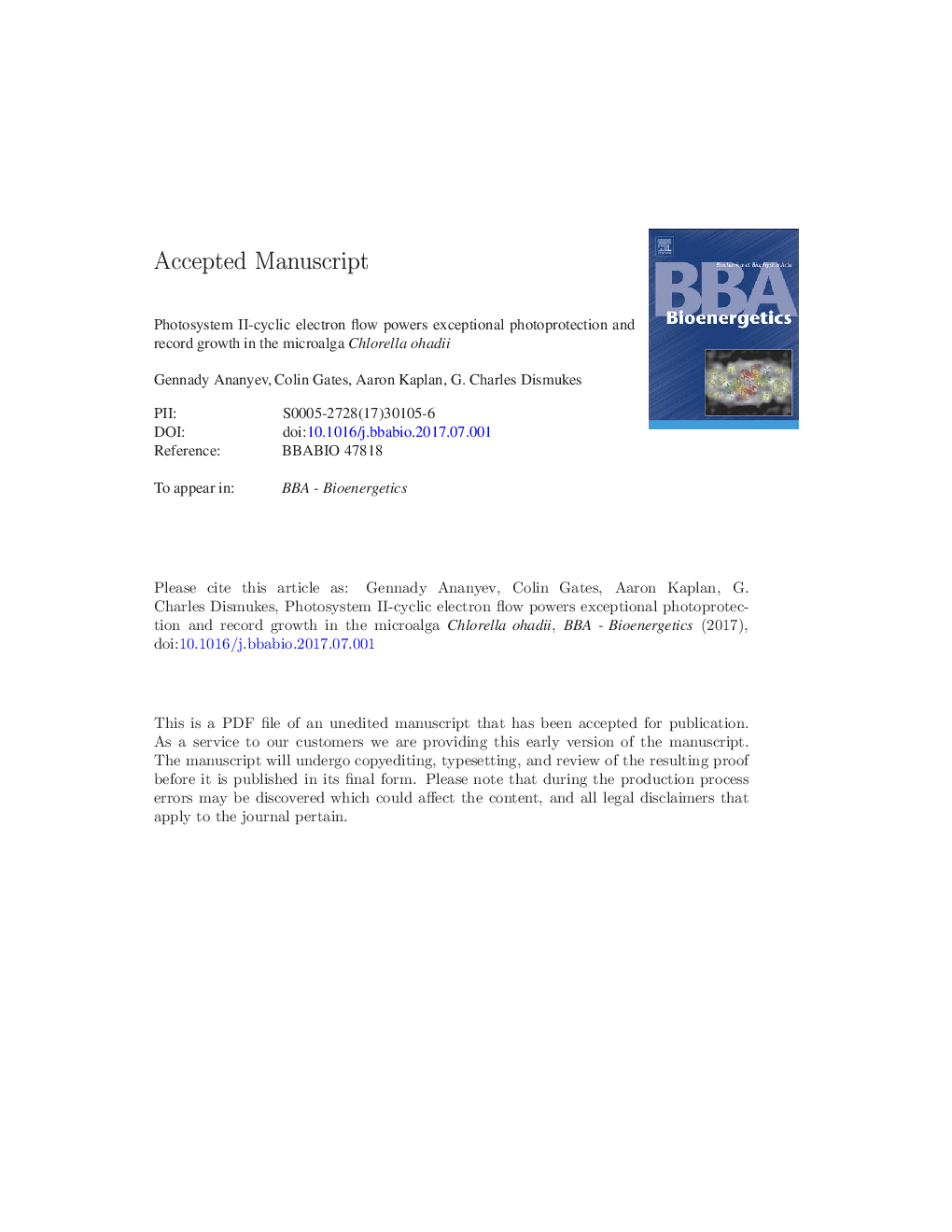| کد مقاله | کد نشریه | سال انتشار | مقاله انگلیسی | نسخه تمام متن |
|---|---|---|---|---|
| 5507151 | 1400314 | 2017 | 36 صفحه PDF | دانلود رایگان |
عنوان انگلیسی مقاله ISI
Photosystem II-cyclic electron flow powers exceptional photoprotection and record growth in the microalga Chlorella ohadii
دانلود مقاله + سفارش ترجمه
دانلود مقاله ISI انگلیسی
رایگان برای ایرانیان
کلمات کلیدی
2,5-dimethyl-p-benzoquinoneDMBQSTFDouble HITWOCDCMUNPQPSIIChlCEFEHL3-(3,4-Dichlorophenyl)-1,1-dimethylurea - 3- (3،4-Dichlorophenyl) -1،1-dimethylureapara-Benzoquinone - para-benzoquinoneQA and QB - QA و QBMISS - از دست دادنCyclic electron transfer - انتقال الکترون سیسیکWater oxidation - اکسیداسیون آبoxygen evolution - تکامل اکسیژنLinear electron flow - جریان الکتریکی خطیCyclic electron flow - جریان الکتریکی سیسیکNon-photochemical quenching - خنک سازی غیر فتوشیمیاییChlorophyll - سبزینه یا کلروفیلQuality factor - ضریب کیفیت، کیو فاکتورQuantum yield - عملکرد کوانتومیDeactivation - غیرفعال کردنPhotosystem II - فتوسیستم 2Single turnover flash - فلش خلاء تنهاLef - لفwater oxidizing complex - مجتمع اکسید کننده آبplastoquinone - پلواستیکینونPhotosynthetic efficiency - کارایی فتوسنتزی
موضوعات مرتبط
علوم زیستی و بیوفناوری
علوم کشاورزی و بیولوژیک
دانش گیاه شناسی
پیش نمایش صفحه اول مقاله

چکیده انگلیسی
The desert microalga Chlorella ohadii was reported to grow at extreme light intensities with minimal photoinhibition, tolerate frequent de/re-hydrations, yet minimally employs antenna-based non-photochemical quenching for photoprotection. Here we investigate the molecular mechanisms by measuring Photosystem II charge separation yield (chlorophyll variable fluorescence, Fv/Fm) and flash-induced O2 yield to measure the contributions from both linear (PSII-LEF) and cyclic (PSII-CEF) electron flow within PSII. Cells grow increasingly faster at higher light intensities (μE/m2/s) from low (20) to high (200) to extreme (2000) by escalating photoprotection via shifting from PSII-LEF to PSII-CEF. This shifts PSII charge separation from plastoquinone reduction (PSII-LEF) to plastoquinol oxidation (PSII-CEF), here postulated to enable proton gradient and ATP generation that powers photoprotection. Low light-grown cells have unusually small antennae (332 Chl/PSII), use mainly PSII-LEF (95%) and convert 40% of PSII charge separations into O2 (a high O2 quantum yield of 0.06 mol/mol PSII/flash). High light-grown cells have smaller antenna and lower PSII-LEF (63%). Extreme light-grown cells have only 42 Chl/PSII (no LHCII antenna), minimal PSII-LEF (10%), and grow faster than any known phototroph (doubling time 1.3 h). Adding a synthetic quinone in excess to supplement the PQ pool fully uncouples PSII-CEF from its natural regulation and produces maximum PSII-LEF. Upon dark adaptation PSII-LEF rapidly reverts to PSII-CEF, a transient protection mechanism to conserve water and minimize the cost of antenna biosynthesis. The capacity of the electron acceptor pool (plastoquinone pool), and the characteristic times for exchange of (PQH2)B with PQpool and reoxidation of (PQH2)pool were determined.
ناشر
Database: Elsevier - ScienceDirect (ساینس دایرکت)
Journal: Biochimica et Biophysica Acta (BBA) - Bioenergetics - Volume 1858, Issue 11, November 2017, Pages 873-883
Journal: Biochimica et Biophysica Acta (BBA) - Bioenergetics - Volume 1858, Issue 11, November 2017, Pages 873-883
نویسندگان
Gennady Ananyev, Colin Gates, Aaron Kaplan, G. Charles Dismukes,